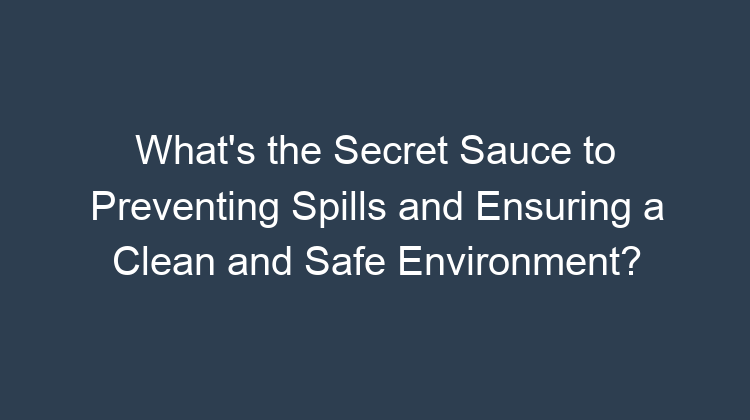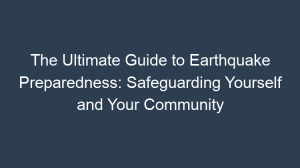Spills are not only messy and inconvenient, but they can also pose serious health and safety hazards. From slippery floors to chemical spills, preventing spills is essential in any environment. In this comprehensive guide, we will explore what constitutes a good practice to prevent spillage, delving into various aspects of spill prevention in different scenarios and industries. We will uncover proactive measures and strategies to minimize the risk of spills, ensuring a clean, safe, and hazard-free environment.
Spills come in various forms and can occur in any setting, be it industrial, commercial, or domestic. From minor kitchen spills to major industrial accidents, the consequences of spills can range from minor inconveniences to catastrophic disasters. Whether it’s a cup of coffee spilled on the kitchen floor or a tanker truck losing its load on the highway, preventing spills is always the best course of action. By implementing proactive measures and following best practices, we can significantly reduce the likelihood of spills and create a safer environment for all.
1. Assessing Spill Risks: Identifying Potential Hazards
The first step towards preventing spills is to identify potential hazards and assess the likelihood and consequences of spills. This involves conducting thorough risk assessments, taking into account factors such as the nature and quantity of materials being handled, the equipment and processes involved, and the work environment. By pinpointing potential spill scenarios, organizations can develop targeted prevention strategies and allocate resources accordingly.
Preventive Maintenance and Regular Inspections
Regular maintenance and inspections of equipment, machinery, and storage facilities are crucial in preventing spills. By identifying and addressing potential issues before they escalate into major problems, organizations can minimize the risk of spills. This includes inspecting pipes, valves, pumps, and other components for leaks, corrosion, and damage. Regular maintenance also involves cleaning and replacing worn-out parts, ensuring that equipment functions properly and reducing the likelihood of failures that could lead to spills.
Spill Containment Systems and Contingency Plans
To mitigate the consequences of spills, it is essential to have spill containment systems and contingency plans in place. Spill containment systems include barriers, dikes, and drain systems designed to contain and divert spills, preventing them from spreading and causing damage. Contingency plans outline the steps to be taken in the event of a spill, including emergency response procedures, cleanup protocols, and communication strategies. Regular training and drills help ensure that personnel are well-prepared to respond effectively and minimize the impact of spills.
2. Safe Handling and Storage Practices
Proper Training and Supervision
Adequate training and supervision are essential to ensure that employees handle and store materials safely. Training should cover the proper techniques for handling, storing, and transporting hazardous materials, as well as emergency procedures in case of spills. Supervision helps ensure that employees follow proper procedures and adhere to safety regulations, reducing the risk of accidents and spills.
Appropriate Storage Facilities and Equipment
The proper storage of materials is crucial in preventing spills. This involves using appropriate containers, tanks, and storage facilities that are designed to safely hold the materials without risk of leakage or rupture. Storage areas should be well-ventilated, dry, and protected from extreme temperatures. Equipment used for handling and transporting materials should be regularly inspected and maintained to ensure its integrity and functionality.
Spill Kits and Personal Protective Equipment (PPE)
Spill kits and personal protective equipment (PPE) are essential for responding to spills safely and effectively. Spill kits contain materials such as absorbents, neutralizers, and protective gear to clean up spills and minimize their impact. PPE includes gloves, goggles, respirators, and protective suits, which help protect personnel from exposure to hazardous materials during cleanup operations.
3. Transportation and Transfer of Materials
Secure Packaging and Labeling
When transporting or transferring materials, it is crucial to ensure that they are securely packaged and labeled. This includes using sturdy containers, properly sealing them, and labeling them clearly with the material’s name, hazards, and emergency contact information. Secure packaging minimizes the risk of leaks or spills during transportation, while proper labeling helps emergency responders identify and handle the materials appropriately in case of an accident.
Safe Loading and Unloading Procedures
Safe loading and unloading procedures are essential to prevent spills during the transfer of materials. This involves using appropriate equipment, such as forklifts or cranes, and following established procedures to ensure that materials are loaded and unloaded safely and securely. Proper training and supervision are also crucial to ensure that personnel follow safe practices and minimize the risk of accidents.
Spill Response and Cleanup
Spills can occur despite the best prevention efforts. Therefore, it is essential to have a comprehensive spill response and cleanup plan in place. This plan should outline the steps to be taken to contain and clean up spills safely and effectively, including the use of spill kits, PPE, and appropriate cleanup methods. Regular training and drills help ensure that personnel are well-prepared to respond to spills and minimize their impact on the environment and human health.







